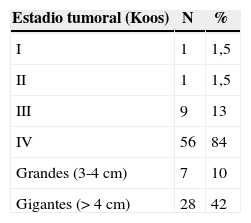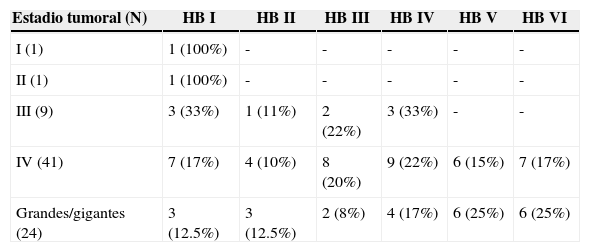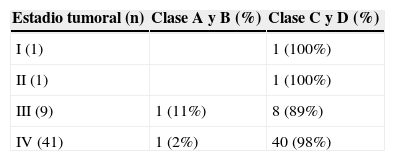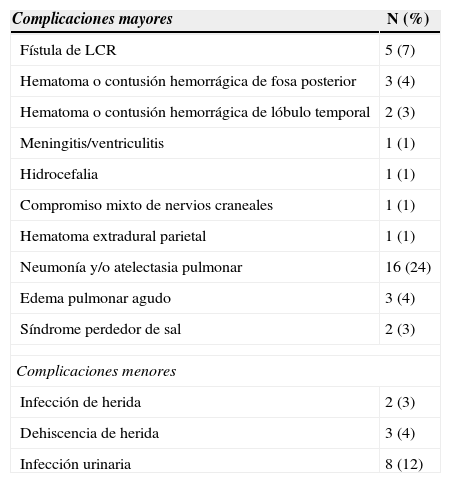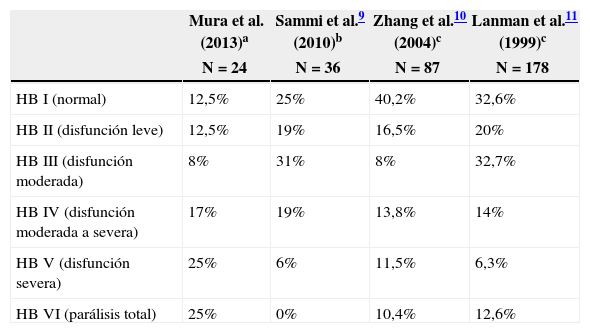Los schwannomas vestibulares (SV) son tumores intracraneanos benignos, cuyo manejo actual es materia de debate, aunque el tratamiento microquirúrgico sigue siendo la modalidad de elección en la mayoría de los casos.
ObjetivoDescribir los resultados quirúrgicos de SV operados en un hospital público chileno.
Material y métodoSe presenta una serie de 67 pacientes tratados quirúrgicamente entre los años 2002 y 2012, en el Instituto de Neurocirugía Asenjo.
ResultadosSesenta y cinco casos (97%), correspondieron a tumores Koos III y iv, de los cuales el 52% fueron grandes (3-4cm) o gigantes (>4cm). Se realizó acceso retrosigmoideo transmeatal en 41 casos (61%). Se logró exéresis total en el 97% y subtotal en el 3% de los casos. A los 6 meses de seguimiento promedio se obtuvo buena función facial (House-Brackmann I o ii) en el 32,7% de los casos y función moderada (House-Brackmann III o iv) en el 42,3%. Las complicaciones cardiopulmonares fueron las más frecuentes (28%) y la mortalidad fue de 1,5%.
ConclusionesLos SV son tumores que pese a su naturaleza benigna pueden causar deterioro clínico significativo en estadios avanzados. Su tratamiento quirúrgico reviste gran complejidad, por lo que este debe ser realizado por equipos especializados para asegurar resultados funcionales óptimos.
Vestibular Schwannomas (VS) are benign intracranial tumors, for which their current management is a matter of debate, although microsurgical treatment remains the mode of choice in the majority of cases.
ObjectiveTo describe the surgical outcome of patients operated on for a VS in a Chilean Public Hospital.
Material and methodA series of 67 patients treated surgically between 2002 and 2012, in the Institute of Neurosurgery Asenjo is presented.
ResultsSixty-five cases (97%) corresponded to Koos III and IV tumors, of which 52% were large (3-4cm) or Giant (> 4cm). Forty-one cases were operated on using a retrosigmoid transmeatalapproach (61%). Total resection was achieved in 97% of the cases and subtotal in the remaining 3%. A mean six months follow-up showed that good facial function (House - Brackmann I or II) was obtained in 32.7% of the patients, and moderate function (House - Brackmann III or IV) in 42.3%. Cardiopulmonary complications were the most frequent (28%), and mortality was 1.5%.
ConclusionsThe VS are tumors that can cause significant neurological deficit in advanced stages, despite their benign nature. Surgical treatment is very complex, and must be performed by specialized teams to ensure optimal functional results.
Article

If it is the first time you have accessed you can obtain your credentials by contacting Elsevier Spain in suscripciones@elsevier.com or by calling our Customer Service at902 88 87 40 if you are calling from Spain or at +34 932 418 800 (from 9 to 18h., GMT + 1) if you are calling outside of Spain.
If you already have your login data, please click here .
If you have forgotten your password you can you can recover it by clicking here and selecting the option ¿I have forgotten my password¿.






